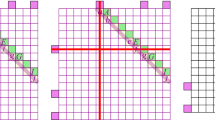Abstract
We design efficient algorithms for on-line learning of axis-parallel rectangles (and for the union of two such rectangles) in the common model for on-line learning with equivalence queries. With regard to the learning of rectangles in arbitrary dimensionsd we solve the following open problem:
Is there an algorithm for on-line learning of rectangles Π di=1 {a i ,a i +1,...,b i } over a discrete domain {1,...,n}d whose error bound is polylogarithmic in the sizen d of the domain (i.e. polynomial ind and logn)?
We give a positive solution by introducing a new design technique that appears to be of some interest on its own. The new learning algorithm for rectangles consists of 2d separate search strategies that search for the parametersa 1,b 1,...,a d ,b d of the target rectangle. A learning algorithm with this type of modular design tends to fail because of the well known “credit assignment problem”: Which of the 2d local search strategies should be “blamed” when the global algorithm makes an error? We propose here a rather radical solution to this problem:each local search strategy that is possibly involved in an error of the global algorithm will be blamed. With this radical solution it is unavoidable that frequently local search strategies will be blamed incorrectly. We overcome this difficulty by employing local search strategies (“error tolerant binary search”) that are able totolerate such incorrect credit assignments. The structure of this learning algorithm is reminiscent of “finite injury priority constructions” in recursive function theory.
Section 4 contains another application of this design technique: an algorithm for learning the union of two rectangles in the plane.
Article PDF
Similar content being viewed by others
Explore related subjects
Discover the latest articles, news and stories from top researchers in related subjects.Avoid common mistakes on your manuscript.
References
Angluin, D. (1988). Queries and concept learning.Machine Learning, 2, 319–342.
Auer, P. (1993). On-line learning of rectangles in noisy environments.Proc. of the 6th Annual ACM Conference on Computational Learning Theory (pp. 253–261). New York: ACM-Press.
Borgstrom, R.S. & Kosaraju, S.R. (1993). Comparison-based search in the presence of errors.Proc. of the 25th Annual ACM Symposium on the Theory of Computing (pp. 130–136). New York: ACM-Press.
Chen, Z. (1993). Learning unions of two rectangles in the plane with equivalence queries.Proc. of the 6th Annual ACM Conference on Computational Learning Theory (pp. 243–252). New York: ACM-Press.
Cohen, P.R. & Feigenbaum, E.A. (1982).The Handbook of Artificial Intelligence, vol. 3, Los Altos, CA: William Kaufmann.
Dhagat, A., Gacs, P., & Winkler, P. (1992). On playing “Twenty Questions” with a liar.Proc. of the 3rd Annual ACM-SIAM Symposium on Discrete Algorithms (pp. 16–22), New York: ACM-Press.
Haussler, D. (1989). Personal Communication.
Littlestone, N. (1988). Learning quickly when irrelevant attributes abound: a new linear threshold algorithm.Machine Learning, 2, 285–318.
Maass, W., & Turán, G. (1989). On the complexity of learning from counterexamples (extended abstract).Proc of the 30th Annual I.E.E.E. Symposium on Foundations of Computer Science (pp. 262–267). Los Alamitos, CA: IEEE Computer Society Press.
Maass, W., & Turán, G. (1994). Algorithms and lower bounds for on-line learning of geometrical concepts.Machine Learning, 14, 251–269.
Maass, W., & Turán, G. (1992). Lower bound methods and separation results for on-line learning models.Machine Learning, 9, 107–145.
Pitt, L. & Valiant, L.G. (1988). Computational limitations on learning from examples.J. of the ACM, 35, 965–984.
Soare, R.I. (1987)Recursively Enumerable Sets and Degrees, Berlin: Springer.
Valiant, L.G. (1984). A theory of the learnable.Comm. of the ACM, 27, 1134–1142.
Author information
Authors and Affiliations
Rights and permissions
About this article
Cite this article
Chen, Z., Maass, W. On-line learning of rectangles and unions of rectangles. Mach Learn 17, 201–223 (1994). https://doi.org/10.1007/BF00993471
Received:
Accepted:
Issue Date:
DOI: https://doi.org/10.1007/BF00993471





